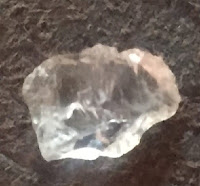 |
| rough diamond |
In the original, Kyle Turpin had allowed as to how diamonds were made of carbon, and then spent a great deal of page space discussing the impurities that give diamonds different colors – pink, yellow, blue... Somma bypassed mos of that and attempted, with some success, to explain that diamonds are almost pure carbon with a few stray atoms of other elements that sneak into the crystal lattice. It's when Marina wandered away from the simple question of the chemistry of diamonds that she ran into problems. We're talking misinformation like...
- "Diamond crystal is formed entirely out of carbon molecules under specific conditions." – Actually, it's all carbon atoms, not "carbon molecules."
- "...This is where the diamond gets its notoriously strong structure from." – Here, Somma confused hardness with "strength." Diamonds actually have well-defined planes of weakness, which is why they can be faceted by a jeweler.
- "...[a] volcano must be deep enough to dislodge portions of the mantle – those that contain the diamonds – and push them to the surface." – Volcanoes aren't "deep," they're surface features. For the most part, only magmatism that is sourced in the mantle produces the kimberlite and lamproite bodies that include xenoliths of diamond-bearing mantle rocks – the source is the "deep" part, not the volcano.
- "Because diamonds must be carried to the surface through volcanic eruptions, it makes sense that you might find them near areas that have historically had volcanic activity." – Well, no, you find them near places where there has been volcanic activity that includes kimberlite eruptions. Those are quite rare, and are not generally near recent volcanism.
- "These kimberlites are rock tunnels made up of ancient molten rock that cooled after a volcanic eruption." – We're loath to think of kimberlite pipes as "rock tunnels," given that kimberlite pipes are vertical instead of horizontal.
As is so often the case, Somma's casual ignorance of earth science resulted in misinformation and a poorly-conceived "fact-lite" version of the genesis of diamonds. Perhaps our Dumbass of the Day should stick to training exotic animals...
SI - MINERALS
No comments:
Post a Comment